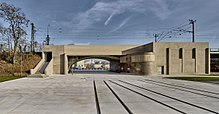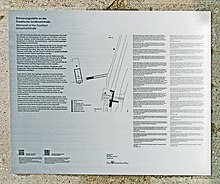Memorial at the Frankfurt wholesale market hall
The memorial at the Frankfurt Grossmarkthalle commemorates the deportation of Jews from Frankfurt am Main during the National Socialist era . From 1941 to 1945 the Secret State Police used the basement of the Grossmarkthalle as a meeting point for the deportation of Jews from the city and the Rhine-Main area . Around 10,050 people were deported from the Grossmarkthalle station in ten mass deportations from October 1941 to September 1942 by freight trains to ghettos, concentration and extermination camps and subsequently murdered. As far as we know today, only 179 deportees survived the Second World War until liberation from National Socialism .
planning
From 2009, the city of Frankfurt am Main, in close cooperation with the European Central Bank (ECB) and the Frankfurt Jewish Community, planned a memorial at the Frankfurt wholesale market hall. This site was intended to remind of the organized murder of the Jews by the National Socialist extermination policy and to provide information about this unique crime. The spatial reference to the historical location of the event should be preserved according to the tender and the public space should be included. 139 architects, landscape architects, urban planners, artists and students took part in the open international competition. In July 2009, a jury chaired by Frankfurt architect Nikolaus Hirsch selected 20 designs for the in-depth discussion from the first competition phase. The jury met again at the end of May 2010. After further revisions of the shortlisted designs, Tobias Katz and Marcus Kaiser finally won the competition in 2011.
It took another four years for the memorial to open. On November 22, 2015, the city of Frankfurt am Main presented the memorial to the public. The Jewish Museum of the City of Frankfurt is currently working on a scientific analysis of the history of the deportations and will be made available to the public in a new permanent exhibition from 2019.
layout
The design for the memorial comes from the architects KatzKaiser from Cologne and Darmstadt . The concept relies on the unobtrusiveness of its elements: selected quotes from murdered Frankfurt citizens, survivors of the Holocaust and observers of the mass deportations. It is based on preserving the preserved fragments from the time of the deportations (cellar, ramp room, signal box, pedestrian walkway, tracks) as they were found and connecting them to one another via new components such as a concrete path. A ramp structure creates the connection to the basement of the wholesale market hall, which is today on the extra-territorial site of the European Central Bank. There the Jewish women, men and children were crammed together, detained, mistreated and the last of their belongings stolen, only to be forcibly abducted on trains of the Deutsche Reichsbahn .
The traditions of these events are permanently inscribed as quotations on the floor and on the walls, in the basement of the former wholesale market hall and in the outside areas of the European Central Bank. For visitors to the ECB and the publicly accessible area adjoining it to the east, the quotes as "inscriptions" on paths and walls not only mark the topographical location of the mass crime, but also follow the chronological sequence of a deportation: from the request to come to the assembly point to be found up to the departure of the trains in the assembly camp in the east. In between there were often only two to three days of immeasurable suffering for the people affected. However, the verbatim evidence also addresses indirect events and emotions, such as suicides in the context of the deportations, reactions from the city's population or reflections on the crime in Frankfurt.
Quotes from perpetrators were not included. Rather, at the authentic site of the crime, the need and hopelessness of those who fell victim to the National Socialist racial ideology should find expression. The perpetrators' statements in their crude bureaucracy and mostly devoid of any empathy would have - according to those responsible - mocked the suffering of more than 10,000 people today.
To illustrate the process of the deportations from Frankfurt, contemporary and more recent quotations were finally selected. This should also include the reflective observation of survivors on what is happening on and in the wholesale market hall. Some of these quotations have come down to us in English; they refer to the exile or the later emigration of the survivors from post-war Germany.
history
From 1941, the Secret State Police rented the eastern basement area of the wholesale market hall as a meeting point for carrying out the mass deportations. The choice fell on this location because of its convenient location close to the city center and the port railway . The basement offered protection from prying eyes and provided makeshift space for hundreds of people to be deported. From there they were driven to the Großmarkthalle station next to the hall , where the Deutsche Reichsbahn trains were ready for transport. In addition, the daily market operations continued unmoved, although the brutal events did not remain hidden from the workers there.
| target | date | Number of people deported | Survivors |
|---|---|---|---|
| Lodz | October 19, 1941 | 1,180 | 3 |
| Minsk | 11/11/1941 | 1,062 | 10 |
| Kovno (Kaunas) | 11/22/1941 | 992 | 0 |
| Majdanek / Izbica | 8.5.1942 | 938 | 0 |
| Majdanek / Izbica | May 24, 1942 | 957 | 0 |
| Majdanek / Sobibor | June 11, 1942 | approx. 1,135 | 0 |
| Theresienstadt | August 18, 1942 | 1,022 | 17th |
| Theresienstadt | September 9, 1942 | 1.109 | 32 |
| Theresienstadt | September 15, 1942 | 1,367 | 105 |
| Raasiku / Estonia | 9/24/1942 | 234 | 10 |
| Auschwitz | March 11, 1943 | 11 | 1 |
| Theresienstadt | March 16, 1943 | 41 | 10 |
| Theresienstadt | April 12, 1943 | 11 | 6th |
| Auschwitz | April 19, 1943 | 17th | 11 |
| Theresienstadt | April 28, 1943 | 1 | 1 |
| Theresienstadt | June 16, 1943 | 19th | 5 |
| Beech forest | October 28, 1943 | 6th | 3 |
| Ravensbrück | October 29, 1943 | 7th | 7th |
| Theresienstadt | 11/10/1943 | 3 | 2 |
| Auschwitz | 1943 | about 100 | 0 |
| Theresienstadt | November 8, 1944 | 56 | 38 |
| Theresienstadt | 3/15/1944 | 7th | 6th |
| Theresienstadt | May 16, 1944 | 1 | 1 |
| Theresienstadt | 4.7.1944 | 7th | 4th |
| Theresienstadt | 10/25/1944 | 9 | 9 |
| Auschwitz | 1944 | about 100 | 0 |
| Theresienstadt | February 14, 1945 | 302 | 291 |
| Theresienstadt | 3/15/1945 | 5 | 5 |
The stories of most of the people deported from Frankfurt can be researched via the database of the Neuer Börneplatz Memorial . It is available to the public in the Judengasse Museum . A total of 12,820 murdered Jews from Frankfurt are known, of which 10,231 were deported by train.
location
The memorial site has a publicly accessible area along the current embankment on Philipp-Holzmann-Weg between Sonnemannstrasse and the banks of the Main . The part of the memorial on the premises of the European Central Bank is only accessible as part of guided tours. These are organized by the Jewish Museum of the City of Frankfurt am Main, which is responsible for the entire educational support of the memorial site.
literature
- Gross, Raphael / Semmelroth, Felix (ed.), Memorial at the Frankfurt wholesale market hall. The deportation of the Jews 1941-1945 , Munich / London / New York 2016.
- Raphael Gross and Felix Semmelroth (eds.), The Memorial at the Frankfurt Grossmarkthalle: The Deportation of the Jews 1941-1945 , Munich / London / New York, 2016.
- Jewish Museum Frankfurt am Main (ed.), "And nobody said Kaddish for us ..." Deportations from Frankfurt am Main 1941 to 1945 , Frankfurt am Main / Basel 2005.
- Jewish Community Frankfurt am Main (ed.), Deportation book of Jews who were forcibly deported from Frankfurt am Main between 1941 and 1944 . Edited by Adolf Diamant, Frankfurt am Main 1984.
- Kingreen, Monica (Ed.), “After Kristallnacht”. Jewish life and anti-Jewish politics in Frankfurt am Main 1938-1945 , Frankfurt am Main / New York 1999.
- Backhaus, Fritz: The deportation of the Frankfurt Jews (The memorial at the Grossmarkthalle) , in: Newsletter. Information on the new building of the European Central Bank in Frankfurt am Main, issue 9, March 2015, p. 5f.
- Commission for Research into the History of the Frankfurt Jews (ed.), Documents on the History of the Frankfurt Jews 1933-1945 , Frankfurt am Main 1963.
- Rieber, Angelika: Traces of Jewish History in Frankfurt am Main 1933-1945 , Frankfurt am Main 1985.
Web links
- Frankfurt am Main 1933–1945
- Video interview on the exhibition "And nobody said Kaddish for us ..." Deportations from Frankfurt am Main 1941 to 1945
- Memorial sites for the victims of the Nazi era in Frankfurt am Main
- The memorial on the website of the Jewish Museum Frankfurt
- stolpersteine-frankfurt.de
Individual evidence
- ^ Department of Planning, Building, Housing and Real Estate - City Planning Office (ed.): Memorial site at the Frankfurt wholesale market hall. Documentation on the competition (Im Dialog 7), Frankfurt am Main 2010
- ^ Kaiser, Markus / Katz, Tobias: Artistic concept of the memorial site (The memorial site at the wholesale market hall), in: Newsletter. Information on the new building of the European Central Bank in Frankfurt am Main, issue 9, March 2015, p. 6
- ↑ Monica Kingreen (Ed.): After the Kristallnacht. Jewish life and anti-Jewish politics in Frankfurt am Main 1938-1945 , Frankfurt am Main / New York 1999 [revised: as of 2017]
- ^ Database of the Neuer Börneplatz memorial
- ^ Adolf Diamant, Deportation Book of Jews Forcibly Deported from Frankfurt am Main in the Years 1941–1944 , Frankfurt am Main 1984
- ^ Jewish Museum Frankfurt: Guided tours of the memorial at the Frankfurt wholesale market hall
Coordinates: 50 ° 6 ′ 35 ″ N , 8 ° 42 ′ 17 ″ E




